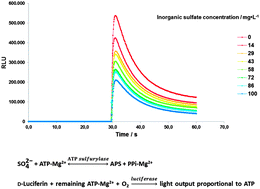An optimized bioluminescent assay for inorganic sulfate quantitation in freshwater†
Abstract
In this paper an optimized enzymatic assay for inorganic sulfate (SO−24) detection and quantitation in freshwater, relying on

* Corresponding authors
a
Centro de Investigação em Química da Universidade do Porto (CIQ-UP), Department of Chemistry and Biochemistry, Faculty of Sciences, University of Porto, Rua do Campo Alegre, no. 687, 4169-007 Porto, Portugal
E-mail:
jcsilva@fc.up.pt
Fax: +351 220 402 659
Tel: +351 220 402 569
In this paper an optimized enzymatic assay for inorganic sulfate (SO−24) detection and quantitation in freshwater, relying on

 Please wait while we load your content...
Something went wrong. Try again?
Please wait while we load your content...
Something went wrong. Try again?
S. M. Marques and J. C. G. Esteves da Silva, Anal. Methods, 2013, 5, 1317 DOI: 10.1039/C3AY26255C
To request permission to reproduce material from this article, please go to the Copyright Clearance Center request page.
If you are an author contributing to an RSC publication, you do not need to request permission provided correct acknowledgement is given.
If you are the author of this article, you do not need to request permission to reproduce figures and diagrams provided correct acknowledgement is given. If you want to reproduce the whole article in a third-party publication (excluding your thesis/dissertation for which permission is not required) please go to the Copyright Clearance Center request page.
Read more about how to correctly acknowledge RSC content.
 Fetching data from CrossRef.
Fetching data from CrossRef.
This may take some time to load.
Loading related content
